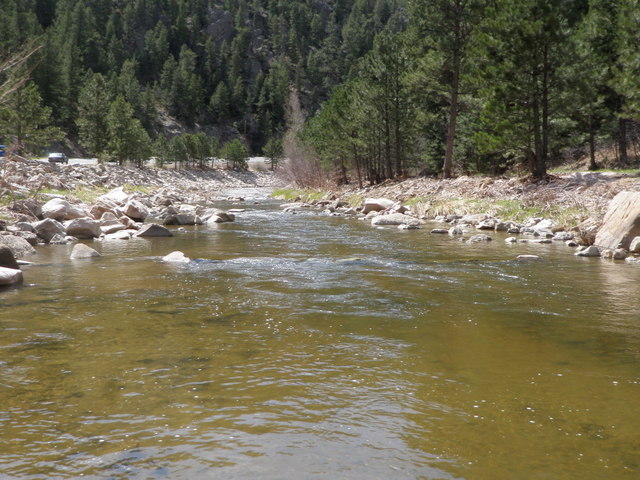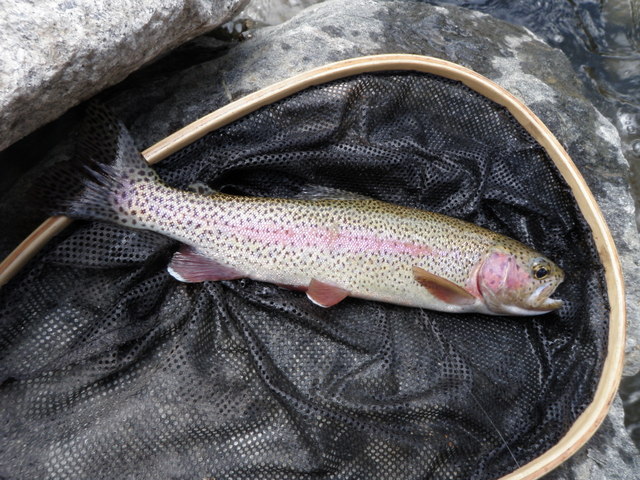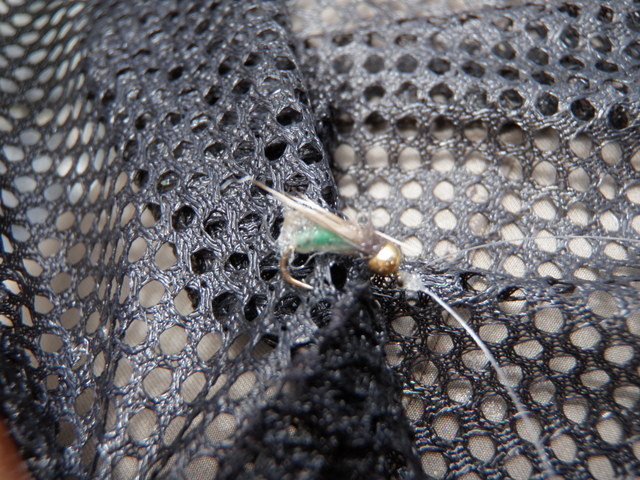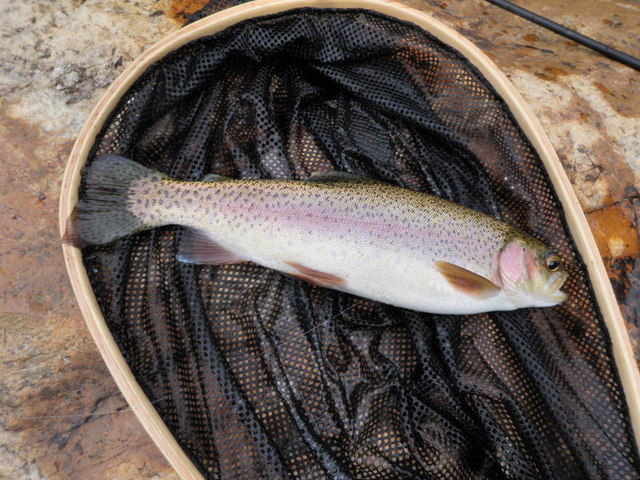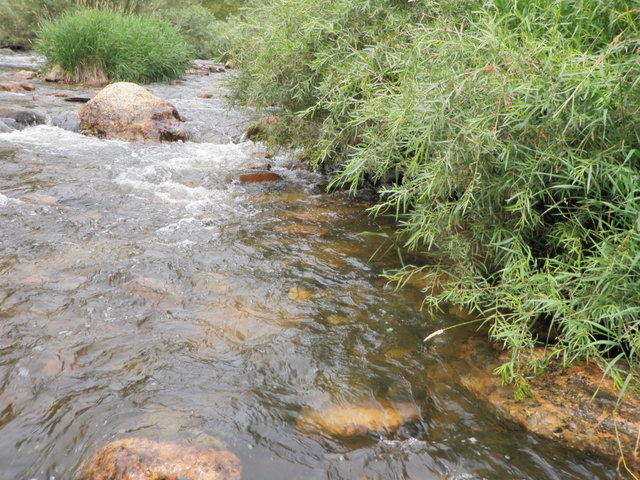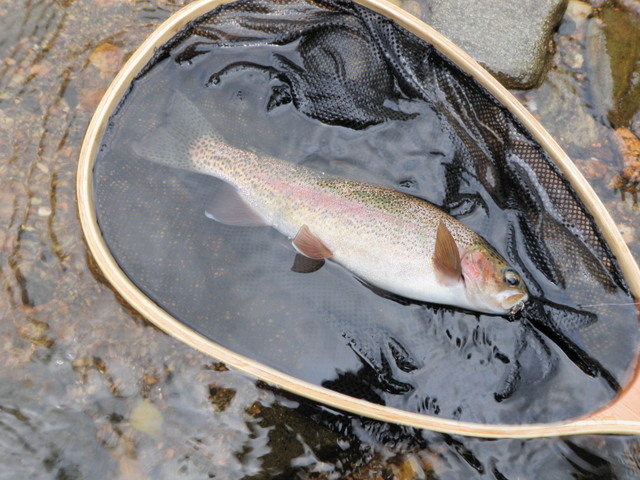Time: 11:30AM – 3:30PM
Location: Downstream border of special regulation water near mile marker 73.
Fish Landed: 10
Big Thompson River 05/09/2016 Photo Album
Having finally conceded that emerging caddis on the Arkansas River were not on my list of 2016 fly fishing successes, I refocused my efforts on other local stream options. High temperatures in Denver in early May remained in the sixties, and this delayed the inevitable run off on Front Range streams. Realizing that I was living on borrowed time, I committed to take full advantage of my retirement status to jam as much fishing into the next couple weeks as possible. Monday was the beginning of promise fulfillment.
On Mothers’ Day Jane and I drove to Rocky Mountain National Park, and we completed several hikes in various popular sections of the park. During these travels I obtained a good look at the Big Thompson in Moraine Park and Cascade Creek along the road to Bear Lake. Both streams were a bit high but very clear. In addition Jane and I traveled along the Big Thompson River in Estes Park and also skirted the North Fork of the St. Vrain northwest of Lyons, CO. All the drainages mentioned remained in fine shape for fishing in advance of the inevitable high muddy snow melt.
On Monday morning I checked the stream flows and fly shop reports on the Big Thompson River in the canyon below Lake Estes, and all the information indicated that this was a solid destination for a day of fishing. I departed from my house at 9:45 and after a stop for gas made the two hour drive and arrived at the extreme downstream boundary of the catch and release water below Lake Estes. I parked facing west near mile marker 73, and I elected to assemble my Sage four weight rod.
The air temperature was in the low fifties so I pulled on my green Columbia fleece to provide added warmth. The fleece remained a critical part of my attire throughout the day, and I added a raincoat and my hat with ear flaps in the afternoon when numerous large gray clouds blocked the sun and held temperatures in the range requiring extra layers.
2013 Scoured the Vegetation
I read some blog posts from previous trips to the Big Thompson in late April and early May, and based on this review, I opted to begin with a single size eight Chernobyl ant. In 2015 at this same time, the solitary Chernobyl produced a solid day, and I did not want to over complicate my choices. Within the first fifteen minutes I generated two split second hook ups with the foam ant, but then the large attractor simply drew refusals. After four or five teasing looks with no take, I decided to experiment with some alternatives. First I tried a smaller size ten Chernobyl, and this also drew some inspections accompanied by rejection. Next I downsized again to a size 14 Jake’s gulp beetle. Although this fly looked more like a real terrestrial than the Chernobyls, it was soundly ignored.
I hoped to avoid the next step in fly experimentation, but several of the reports I read referenced success with dropper flies. I returned the size eight Chernobyl to the end of my line, and then I added a three foot dropper with an emerald caddis pupa attached. This combination finally delivered my first fish of the day at 12:30. I celebrated the success of the emerald caddis pupa by breaking for lunch.
Quite a Meal for This Little Guy
As I munched my sandwich on a large rock near the river, I observed two small blue winged olives. I was not surprised by this development because the sky was growing increasingly overcast, and perfect blue winged olive weather arrived. When I resumed my upstream progress, I added a Craven soft hackle emerger to my dry/dropper configuration. I was now certain that I had the correct combination of flies to accumulate some landed trout over the remainder of the afternoon. My last remaining hope, the ability to cross the river flowing at 97 cfs, finally reached fruition when I found a section with a wide and relatively shallow depth. I was now positioned to prospect the most attractive pools, runs and pockets on the side of the river away from the highway and less pressured by most fishermen.
A Nice Shelf Pool Produced a Rainbow
Between 1PM and 3:30PM I built my fish count to ten. I would be embellishing the truth to state that it was hot fishing, but my catch rate was steady. The entire lower section of the catch and release area belonged to me, and I took full advantage by moving quite rapidly from prime run to juicy hole. I disciplined myself to deliver only three to five casts depending on the quality of the location. Most of the landed fish were on the small side, but I also netted a twelve inch rainbow and a couple eleven inch brown trout.
Lots of Pockets and Pools
The overwhelming highlight of the afternoon unfolded when I reached a deep pocket where two currents merged. One small flow skirted below a large exposed boulder at the very top of the small pool. A larger run merged at an angle from the right. Initially I was certain that any resident fish would hold out in the deep pit in front of the merging currents, but my drifts through this area proved fruitless. The small run that flowed from the left was only two feet wide, and a small foam slick hovered just below it. I lobbed a cast to the left side so that the smaller current carried the flies along the edge of the foam and, wham, a fish nose appeared beneath the Chernobyl. I reacted with a swift hook set, and I was certain that the fish inhaled the ant.
The fish reacted to my quick lift by making a dive and then thrashing around the perimeter of the pocket. Either I connected with a decent fish, or I foul hooked a smaller trout when it refused the Chernobyl. I held my breath and maintained tension on the line as the fish slid downstream into some moderately faster water. I followed it for a few steps until I could lever the head above the surface and guide it to my net. Much to my delight the fish in my net revealed the emerald caddis pupa in its mouth, and a quick glance told me that it was the largest brown trout I ever caught in the Big Thompson River. In fact it was likely the biggest trout of any kind that I landed in the Big T. Once Mr. Brown settled in the net, I estimated that it was sixteen inches long, and it carried a decent amount of weight for its length.
Beautiful Fish
Monday proved to be a solid day on the Big Thompson. Ten fish landed in 3.5 hours of fishing represents a reasonable catch rate, and the Big Thompson trophy brown was icing on the cake. I moved about freely and used my dry/dropper method effectively. Three of the ten smashed the Chernobyl on the surface, two fish nabbed the soft hackle emerger, and the remainder were attracted to the emerald caddis pupa. Clearly Monday was solid justification for maintaining wellerfish.me, as my review prompted me to use the Chernobyl ant and the emerald caddis pupa. Four more weekdays remain in the current week, and the weather forecast improves with each additional day. I cannot wait.

